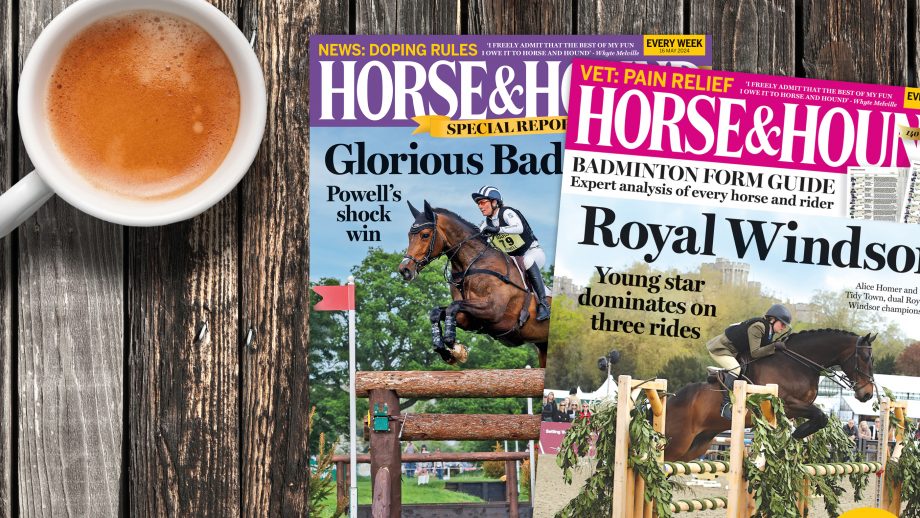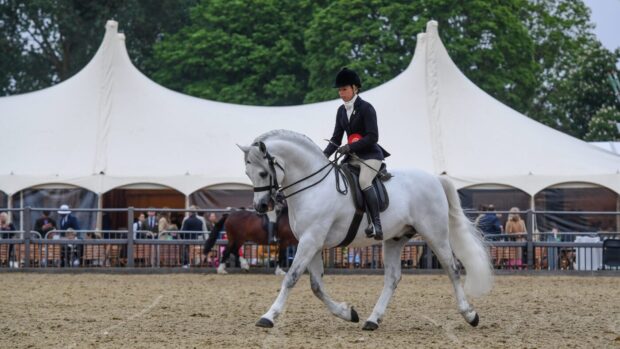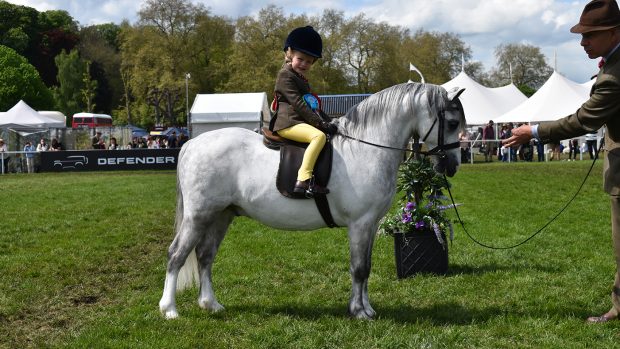Anyone who has watched ridden heavy horses in the show ring will know that they are a treat for spectators. Whoever imagined such giants could be as balanced and light-footed as a hack?
Horses aimed at the Heavy Horse of the Year HOYS qualifiers must be registered with the British Studbooks of the Shire, Clydesdale, Suffolk or British Percheron Society. But as you take a moment to enjoy the spectacle, do you really know your Shire from your Clydesdale, or which is the Suffolk and which is the Percheron?
Let us shed some light on each of them so you’re up to speed when you find yourself cheating your way through a chat at the ringside…
The Shire Horse
How to spot a Shire
Shires come in black, brown, bay or grey, though there are actually very, very few greys. The breed standards state that you won’t find large splashes of white on the body of a “good stallion” and they must not be roan or chestnut. It is, however, acceptable for geldings or mares to be roan. The Shires of yesteryear had abundant feather but today’s Shire has straighter, silkier and finer feather.
On average, Shires are between 17 and 18hh, but geldings and mares may be a teeny bit smaller. The Shire and Clydesdale are pretty similar in build, but the Shire is generally slightly taller with horses sometimes reaching over 20hh. Also, the hindquarters might be a little different, with those of a Shire being “long and sweeping” and thighs should be well muscled. In motion, a Shire should be a powerful, straight over, using hocks and knees, with the former close together.
Clues from turnout
An in-hand Shire is a feast for the eyes, with tail ribbons and standing wire flights adding a burst of colour to an already impressive sight. Ridden Shires don’t wear standing flights for safety reasons. Instead, you’ll find a braid in their manes and a ribbon in tails.
How to cheat your way through a ringside chat on the Shire
Originally known as the English Cart Horse, the breed’s name changed to the Shire in 1878. Though they were immensely popular pre mechanisation, industrialisation and the world wars, the Shire’s numbers declined enormously until there were just 16 foals registered in the 1958 stud book, according to the Shire Horse Society. So, just like the other native breeds eligible for competition, the Shire is on the Rare Breeds Survival Trust’s equine watchlist, and is categorised as “at risk”.
Impress your friends with: Did you know, the last three winners of the ridden heavy horse class at HOYS have been Shires? The Shire has a brilliant track record in the ridden heavy horse of the year championship, with Moorfield Nancy being the most recent winner last season – 2024 – under Alice Pimbley.
The Clydesdale
How to spot a Clydesdale
The Clydesdale is, on average, a smidge smaller than the Shire, at a not-so-whopping 17 to 18hh. Some mares will measure slightly smaller, and some geldings and stallions slightly taller. Though a Clydesdale should be strong with good depth, spring of rib and rounded quarters – like any good draught horse – the Clydesdale tends not to be as stocky as the Suffolk or Percheron.
According to the breed society’s criteria, a Clydesdale’s legs should be “set close together” and its hind legs should have a “lengthy” distance between hocks and pasterns “with an absence of a second thigh above the hock”. This gives way to the unique and free action of the Clydesdale.
Like the Shire, bay and brown and roan are most common, but you’ll occasionally happen across a black and chestnut, too. White markings tend to travel further up the legs than on a Shire, and it’s not uncommon to see white legs blend into a roan fleck on the body. A Clydesdale without a blaze is a rare sight.
Clues from turnout
Clydesdales will usually don a ribbon in their tails, and stallions and geldings wear braided manes, but female Clydesdales traditionally don’t.
How to cheat your way through a ringside chat on the Clydesdale
The Clydesdale is Scotland’s only native horse, and it’s always a pleasure to catch the Royal Highland’s bountiful ridden Clydesdale class. It originates in Lanarkshire, Clydesdale being the old name for the district, and dates back to the mid 18th Century when Flemish stallions were crossed with Lanarkshire’s native horses. During the 1970s the breed was considered “vulnerable” by the Rare Breeds Survival Trust, but has since increased in numbers to the “at risk” category.
Impress your friends with: Did you know, the Clydesdale also has a really good track record in the Ridden Heavy Horse of the Year championship at HOYS? In fact, the inaugural championship was won by Scottish duo, Virginia Osborne and Kinclune Danny Boy in 2016. A second Scottish duo, Kirsty Aird and Glenside Matthew’s Flower Of Scotland won in 2021.
The Suffolk horse
How to spot a Suffolk Horse
Suffolks are easy to spot. The Suffolk is for fans of fiery red hair, with liver, dark, red, light or bright chesnuts being the only colours allowed. No, that’s not a typo; when referring to the Suffolk horse, the colour chestnut is always spelled chesnut.
“Plain” – for want of a better word to describe this brilliant colour – chesnut is preferred, but according to breed standards, a certain amount of white is acceptable on the face, as is a “scattering” of white or silver hairs on the body. White to the fetlock is allowed, but considered a fault and is not acceptable in stud stallions.
Today’s Suffolk is a little taller than the 15.2hh of the original Suffolk, Crisp’s Horse. According to their breed society standards, a mature Suffolk will be between 15¾ and 17hh. Suffolks are squarer and chunkier in the body than Shires and Clydesdales, with a huge shoulder and proportionally short legs, so they may not have the extravagant knee and hock action of the other three breeds.
Clues from turnout
The Suffolk is shown with a ribbon in a plaited tail. Like the Shire, it wears standing wire flights in hand, but will be found shown with a single plait down the mane and a ribbon at the wither in ridden classes.
How to cheat your way through a chat on the Suffolk horse
According to the RBST, the Suffolk horse is the most endangered of our draught breeds, being the only one in the “priority” category. The Suffolk’s numbers were decimated post WWI by the mechanisation of agriculture, until just nine Suffolks were registered in 1966. Thankfully, they have regained popularity.
Impress your friends with: Did you know that so far, a Suffolk hasn’t won the Ridden Heavy Horse of the Year championship? Richard Telford came a close second in 2016 with Eyke Diamond.
The Percheron horse
How to spot a Percheron
Just like the Suffolk, a good Percheron won’t have much feather. But you won’t find them in “chesnut”. Instead, a Percheron horse is grey or black, with a minimum of white, although the society recognises that colour will tend to lighten in older horses.
Like its chestnut rival, the Percheron is also squarer in appearance than the Shire or Clydesdale. Mares should be a minimum of 16.1hh, and stallions or geldings a smidge bigger, being at least 16.2hh.
Clues from turnout
Rely on colour, because again, manes should be braided irrespective of sex, and tails should be plaited with a ribbon, so not much to go on from turnout!
How to cheat your way through a ringside chat on the Percheron
Though we’re not entirely sure how long the Percheron horse has been on British soil, we know it’s been around a long time, with the first one appearing as far back as William the Conqueror’s invasion of England.
According to the British Percheron Horse Society, it’s also believed that thousands of Percheron-esque horses were imported to Britain from North America during the latter half of the 19th Century for omnibuses and other light draught work in big towns. Nowadays, you may have seen Percherons being ridden by police, including at the late Queen Elizabeth II’s funeral.
Impress your friends with: Although there aren’t as many Percherons competing in the ridden classes as there are Clydesdales and Shires, they are successful. In 2017 fans saw a Percheron win at HOYS – Hales Hector was ridden to victory by Household Cavalry Corporal of the Horse, Jamie Bradbury.
Now just remember to have this guide open on your mobile as you’re watching, and you’ll know what’s what in no time!
- To stay up to date with all the breaking news from major shows throughout 2025, subscribe to the Horse & Hound website
You may also be interested in:

Standing tall: the five breeds featuring the world’s biggest horses

The ‘do-all draft horse’: a snapshot of the versatile Percheron

‘She is pure elegance’: 15-year-old mare leads HOYS heavy horses after phenomenal performance

Subscribe to Horse & Hound magazine today – and enjoy unlimited website access all year round





